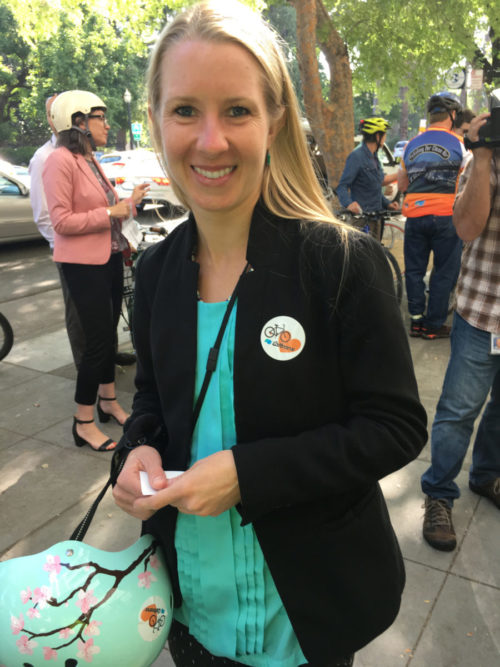Almost two years ago, Streetsblog interviewed Caltrans newly hired Chief of Pedestrian and Bicycle Safety, Rachel Carpenter to find out what she was planning to accomplish in her new position, and how she was going to do it. The challenges she faced were substantial, among them dealing with a giant bureaucracy famous for slow and cumbersome processes and engineers whose notion of safety was firmly rooted in the concept of keeping cars moving quickly and smoothly.
Streetsblog caught up with Carpenter recently to find out what progress she has made. Her priorities when she started were: collecting better data, creating a training program for Caltrans staff, and finding ways to improve collaboration and communication between Caltrans and its partners.
In the short time she's been at Caltrans, she has achieved a lot in these areas. At the same time, her progress shows how much more work there is to do.
Carpenter started with a focus on pedestrian safety. Her first project was to begin assessing where pedestrian crashes regularly occur and what could be done about them. Under the pilot program so far, Caltrans has completed 129 safety investigations at sites along California state highways with high pedestrian crash rates, and those investigations have resulted in 29 capital projects and 54 maintenance work orders.
The work orders are quick projects that Caltrans crews can just go out and take care of—things like lane striping changes and sign modifications.
The capital projects are bigger and take more time to plan. They include adding pedestrian hybrid beacons and accessible pedestrian signals, fixing gaps in sidewalks, and improving street lighting. One capital project is the Route 135 Pedestrian Safety Improvement project in Santa Maria, which includes safety measures for pedestrians and also improvements for people on bikes, including new signals with pedestrian countdowns, curb ramps, marked crosswalks, new sidewalks, a wider shoulder, and street lighting.
Carpenter said these 29 projects will be implemented through the State Highway Operation and Protection Program (SHOPP), which includes a pot of funding specifically for safety projects. “Once we determine a safety need, it's automatically included in the funding list,” said Carpenter, “so these projects don't compete with other the SHOPP funds.”
A similar Bicyclist Safety Improvement Monitoring (Pilot) Program was just launched this past April. So far it has identified over 250 locations that will be investigated in the same way as in the pedestrian program.
But Carpenter encountered an unexpected problem with fourteen of the locations that were identified as high-injury problem spots. At those locations, Caltrans district engineers concluded that they could make “no engineering recommendation.”
“That sort of caught me off guard,” said Carpenter. It meant that the engineers, after studying the collision report and investigating the site, came to the conclusion that there was nothing they could do, through street redesign or other engineering changes, to prevent those crashes.
But Carpenter didn't just let it end there. Her team created a “No Engineering Recommendation” task force—with representatives from the highway patrol, the Office of Traffic Safety, the Department of Health, and the Department of Alcoholic Beverage Control—to look more deeply into the causes of crashes at those sites and other similar sites.
It also made her realize that Caltrans staff need more training. When she started at her new position, she said, she quickly realized that a big part of her job would be quickly rolling out changes on the ground. “But another major part is training, so our staff know about options, and so they can make needed changes.”
She has created both pedestrian safety training courses and bike infrastructure training. “I put together a five-year training plan,” she said, “that alternates very other year between bike and pedestrian safety issues.” Most are intensive two-day courses that include information about the new bike and pedestrian safety monitoring programs, including how to identify and investigate problem sites and what kinds of countermeasures can be applied.
“Things are changing so quickly,” said Carpenter. “The field is evolving rapidly, and we need training constantly. Luckily, district staff is really open to being trained.”
The trainings, in addition to being customized to the local context, include discussions of pop-up demos, planning considerations, thinking about where pedestrians want to walk—not just trying to force them to walk a particular path—and who to provide safer routes to transit and through intersections. “It's very safety and engineering focused,” said Carpenter.
For the bike classes, she has also rented bikes for everyone in the class and had everyone ride to lunch together. “The course evaluations were interesting,” she said. “People called it eye-opening, just to ride to lunch.”
In addition to expanding this necessary training, Carpenter is also in the midst of building a first-in-the-nation State Highway Pedestrian Exposure Estimate Map that shows where people are already walking.
The model combines short-term pedestrian counts from more than 1200 intersections—data the team has been collecting from a wide variety of sources, in conjunction with UC Berkeley's SafeTREC--with information about population, employment density, and the existing street network.
In her spare time, Carpenter has also proposed changes to the California Manual of Uniform Traffic Control Devices—which is notorious for the ponderousness of its processes. That has resulted in the addition of traffic control devices for class IV bikeways and “pocket” bicycle lanes, and a major revision to the section that discusses shared lane markings (sharrows).
Carpenter has clearly made huge progress in two years. She has much more to do. Let's hope Caltrans gives her more resources, and a bigger team, to back up their commitments to pedestrian and bicycle travel modes.
Follow Streetsblog California on Twitter @StreetsblogCal






